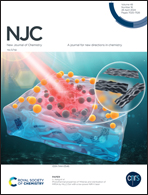Adsorption behavior of chloramphenicol on an activated carbon from pomelo peel using KHCO3 activator†
Abstract
Overuse of antibiotics causes environmental pollution, and activated carbon adsorption is an effective way to remove antibiotics from polluted water. Herein, a cost-effective biomass carbon adsorbent for the adsorption of chloramphenicol (CHL) was prepared from pomelo peel using KHCO3 activator. The activated carbon boasted a significant specific surface area (SBET) of 1608 m2 g−1 with a maximum adsorption capacity (Qmax) for CHL reaching 549.5 mg g−1. The effect of adsorption behavior on adsorption capacity was studied. The adsorption process followed the pseudo-second-order kinetic and Langmuir models. From combined FT-IR and XPS data, the adsorption action included both physical adsorption and chemical adsorption. The rate-limiting step was diffusion through the boundary layer. The adsorption mechanism mainly included the processes of pore filling, functional group binding, and hydrogen bond and π–π interactions. Thermodynamic parameters demonstrated spontaneous and exothermic properties. This work demonstrated the rational application of waste biomass carbon for efficient adsorption of antibiotics to provide new help for antibiotic removal from polluted water.



 Please wait while we load your content...
Please wait while we load your content...